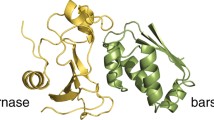Abstract
The role of water molecules on the protein-ligand interface during macromolecular association has been determined. The free energy of association of insulin has been calculated by the methods of molecular mechanics and continual electrostatics (Poisson-Boltzmann model). The previously developed scheme of the decomposition of association free energy onto contributions from individual interactions has been used to calculate intermolecular interactions, the solvation free energy, and the entropies of the process of macromolecular association. An analysis of the calculated oscillation spectra indicated that the presence of water molecules on the protein-protein interface promotes an increase in the contribution of vibration entropy to the free energy of association due to the enhancement of the flexibility of the complex. It was shown that water molecules involved in the formation of protein-water-ligand hydrogen bond network change the balance of forces in the system.
Similar content being viewed by others
References
R. Huber and W. Steigmann, J. Mol. Biol. 889, 73 (1974).
J. Janin and C. Chotia, J. Mol. Biol. 100, 197 (1976).
K. Wutrich, Cold. Spring. Harbor. Symp. Quant. Biol. 58, 149 (1993).
J. Janin, Structure 7, 277 (1999).
T. N. Bhat, G. A. Bentley, G. Boulot, et al., Proc. Natl. Acad. Sci. USA 91, 1089 (1994).
M. Billeter, Proc. Mag. Res. Spectr. 27, 635 (1995).
A. G. Yakovlev and V. A. Shuvalov, Biokhimiya 68, 603 (2003).
R. K. Ledneva, A. V. Alekseevskii, S. A. Vasil’ev, et al., Mol. Biol. 35, 647 (2001).
L. LoConte and J. Janin, J. Mol. Biol. 285, 2177 (1999).
A. R. Dunn, I. J. Dmochowski, A. M. Bilwes, et al., Proc. Natl. Acad. Sci. USA 98, 12420 (2001).
S. Fischer and C. S. Verma, Proc. Natl. Acad. Sci. USA 96, 9613 (1999).
S. Fischer, J. C. Smith, and C. S. Verma, J. Phyz. Chem. 105, 8050 (2001).
Y. Takano, S. Yamagata, and K. Yutani, Protein Eng. 16(1), 5 (2003).
S. Y. Noskov and C. Lim, Biophys. J. 81, 737 (2001).
A. D. Mackerel, D. Bashford, M. Bellot, et al., J. Phys. Chem. B. 102, 3586 (1998).
W. Im, D. Beglov, and B. Roux, Comput. Phys. Commun. 109, 1 (1998).
M. Nina, D. Beglov, and B. Roux, J. Phys. Chem. B. 101(26), 5239 (1997).
E. J. Dodson, G. G. Dodson, R. E. Hubbard, et al., Phyl. Trans. Royal. Soc: Series A 345, 153 (1993).
J. Brange, U. Riebel, J. F. Hansen, et al., Nature 333, 679 (1988).
B. Tidor and M. Karplus, J. Mol. Biol. 238, 405 (1994).
G. Giraud, J. Karolin, and K. Wynne, Biophys. J. 85, 1903 (2003).
V. Crupi, D. Majolino, P. Migliardo, and V. Venuti, Philos. Mag. B-Phys. Condens. Matter Stat. Mech. Electron. Opt. Magn. Prop. 82, 425 (2002).
J. C. Smith, F. Merzel, C. S. Verma, and S. Fischer, J. Mol. Liquids 101, 27.
Author information
Authors and Affiliations
Corresponding author
Additional information
Original Russian Text © S.Yu. Noskov, M.G. Kiselev, A.M. Kolker, 2010, published in Biofizika, 2010, Vol. 55, No. 1, pp. 39–45.
Rights and permissions
About this article
Cite this article
Noskov, S.Y., Kiselev, M.G. & Kolker, A.M. Role of bound water in protein-ligand association processes. BIOPHYSICS 55, 29–34 (2010). https://doi.org/10.1134/S0006350910010069
Received:
Accepted:
Published:
Issue Date:
DOI: https://doi.org/10.1134/S0006350910010069




